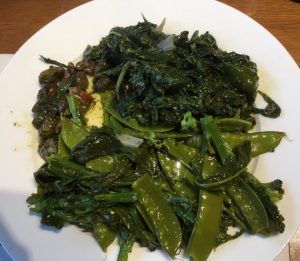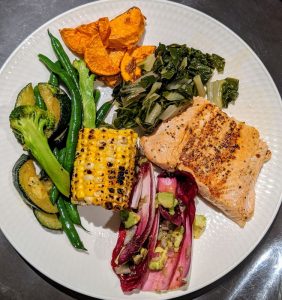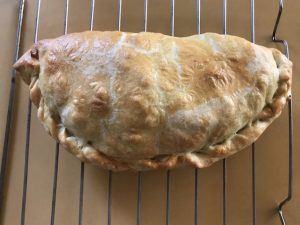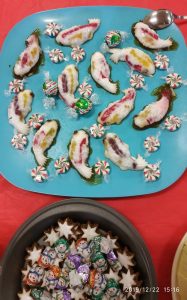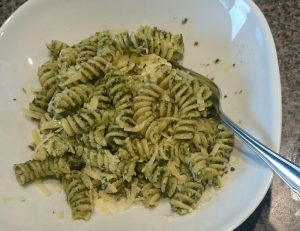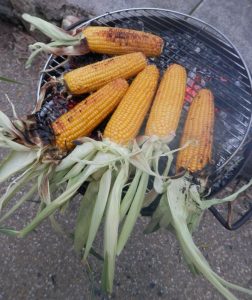Thanks to all the people who have contributed to this week’s newsletter: Angelo Eliades, Cathy Romeo, Chloe Thomson, Dave Chambers, Deb Thomson, James Reeves, Kate Lahiff, Linda Cornelissen, Lynn Wallace, Marianthi Kougi, Meaghan Clayton, Meera Govil, Megan Goodman, Nancy Mills, Penny Smith, Rebecca Gray, Rita Varrasso, Robin Gale-Baker, Soo Mei Leong, Tracey Bjorksten and Vicki Paras.
What farmers’ markets will be happening this weekend?
On Saturday: Carlton and Coburg.
On Sunday: Alphington and Eltham.
A new local gin maker – Mary Monica Gin
 Mary Monica Gin only started out business in 2020 and their first product is called ‘oriental gin’, which is a south east asian inspired citrus gin. They live on a regenerative citrus farm in Yarra Glen where they grow the botanicals used to flavour their gins. Their key botanicals are picked fresh in season and distilled within 24 hours. This means that, when the season’s batch is sold, they do not produce any more gin until the next fruit is on the trees. You can buy their gin online or at Eltham Farmers’ Market (where they have a stall on the 1st Sunday of every month, including this upcoming Sunday, 4th October). Read their Local Food Directory entry on our website. Welcome James!
Mary Monica Gin only started out business in 2020 and their first product is called ‘oriental gin’, which is a south east asian inspired citrus gin. They live on a regenerative citrus farm in Yarra Glen where they grow the botanicals used to flavour their gins. Their key botanicals are picked fresh in season and distilled within 24 hours. This means that, when the season’s batch is sold, they do not produce any more gin until the next fruit is on the trees. You can buy their gin online or at Eltham Farmers’ Market (where they have a stall on the 1st Sunday of every month, including this upcoming Sunday, 4th October). Read their Local Food Directory entry on our website. Welcome James!
How much sun do veggies need? An article by Robin Gale-Baker
Expert gardeners often bandy around certain terms as though we will automatically know what they are talking about. But do we? When it comes to terms like full sun, partial sun, partial shade and full shade, what do these really mean? And is afternoon sun the same as morning sun? As discussed below, the answers to these questions are a little more complex than at first might be expected.
The first point is that some people use the terms ‘partial sun’ and ‘partial shade’ interchangeably. However, drawing a distinction between the two is important because some plants in this broad category need more sun and are more heat tolerant and therefore need afternoon sun whilst others do poorly in afternoon sun and need morning sun. So, in this article:
- Full sun means 6-8 hours of direct, unfiltered* sun per day.
- Partial sun means 3-6 hours of full, unfiltered* afternoon sun per day.
- Partial shade refers to 3-6 hours of morning sun as opposed to afternoon sun.
- Full shade means less than 3 hours sun per day (according to some definitions) to no direct sunlight at all (according to other definitions).
*Unfiltered means that there is nothing in the way of the sun’s rays such as tree branches or shadowing.
There is also a nonsense term – full sun, partial shade. It’s one or the other! What it really means is that the plant will survive in partial shade but will not thrive or produce ripe fruit.
Because the rays of the sun pass through more of the atmosphere in the morning, sunlight is less intense before midday. In the afternoon, the sunlight is hotter than in the morning. Around midday, when the sun is directly overhead, it is strongest.
How hot the sun appears also depends on our latitude. Information from gardening books written for England and Europe will reflect their conditions not ours. Top temperatures in these regions in summer are usually 10 degrees below what we experience in Melbourne and this needs to be factored in along with the actual hours of sunlight. Local conditions are important!
While drought-tolerant and heat-tolerant plants, such as silver and grey plants and tough woody herbs, can tolerate hot sun for 9 hours a day, most veggies would burn in those conditions. Blistering, sunburn and heat stress are serious problems when we experience extreme summer heat, especially when temperatures hit the 40s.
But all vegetables need some sun to grow so none will grow well in total shade.
Within these two extremes:
- Vegetables which produce fruits generally like full sun, as the sun is an important element in producing the starches and sugars that give these vegetables their flavour. This includes tomatoes, eggplants, capsicum, chilli, cucumber, zucchini, pumpkin, sweetcorn, beans, peas and rockmelons. If you do not have sufficient direct sunlight for tomatoes, choose cherry tomatoes which because of their small fruit, will ripen with 3-4 hours sunlight. Plant eggplant in the hottest part of your garden, then capsicum in the second hottest and tomato in the third hottest area. Rockmelons do well if planted above fresh manure which acts as a heat bed early in the season when they require warm soil temperature to get an early enough start to produce fruit later in the season. Eggplants and capsicums, which need soil temperatures in the 20-30degC range to germinate, are best bought as seedlings, unless you have a heat mat, otherwise, like rockmelons, they will produce fruit too late for it to fully mature. Sun-loving vegetables will not produce a good, fully ripe crop with less than 6 hours direct sun per day, and can tolerate 8 hours. Beans and peas need full sun early in their season but do badly in the height of summer when it is too hot for them.
- The onion family also likes full sun. This includes onions, garlic, spring onions, shallots and leeks.
- Vegetables that produce roots grow best in partial sun – that is afternoon sun and morning shade. This includes carrots, parsnip, turnips, beetroot, radishes and potatoes.
- Vegetables where you eat the stems, buds or leaves generally prefer partial shade – that is morning sun and afternoon shade. These include brassicas such as kale, cabbage, broccoli, Brussels sprouts and cauliflower, and leaf crops such as silverbeet, spinach, cress, rocket and lettuce. It also includes celery, kohlrabi and globe artichoke. The darker the leaves, the less light the plant needs to grow (with silverbeet, spinach and watercress being examples). Be careful not to overwater vegetables growing in shade as there may be insufficient sun to dry the ground.
Yes, you did know!
Last week, Jacinda Brown asked whether she could graft a fruiting grape onto an ornamental grape. Angelo Eliades has replied: “Ornamental grapes are either Vitis vinifera, whose leaves look like regular grapevine leaves, or Vitis coignetiae, also known as Crimson Glory Vine, which has broad, slightly lobed leaves. Here in Australia, both our table grape and our wine grape varieties are the Vitis vinifera species.
“So, if your ornamental grape is Vitis vinifera, you can graft fruiting grapes onto it.
“If your ornamental grape is Vitis coignetiae, I’m not sure if you can graft fruiting grapes onto it. A literature search yielded no results but it is common practice in agricultural settings to graft Vitis vinifera onto other Vitis species rootstock for disease resistance, and several other grape species are used for the purpose, so it’s quite likely that you can do the grafting.”
Do you know?
Meaghan Clayton asks: “I have a glut of broad beans however I am yet to find a recipe where I have enjoyed eating them. Can anyone suggest the most tasty ways to cook them?” Email your answers.
Rebecca Gray asks: “I want to plant a grapevine and need to understand how far reaching its roots will get. I have clay soil and have had cracking problems on the house (brick walls) with other vegetation planted close to the house. How far away should a grapevine be planted to avoid cracking a brick wall?” Email your answers.
Nancy Mills has a follow up question to her previous question about composting of disposable coffee cups: “Has anyone actually tried composting any kind of recently-produced packaging materials labelled as compostable or home-compostable and, if so, what was the end result?” Email your answers.
Newsletter readers’ food growing tips
Lynn Wallace: “To prevent earwigs infesting sweetcorn, cut the top and bottom off a plastic milk bottle (3 litre is a good size). Push into the soil so that ⅓ of the ‘sleeve’ is underground. Plant the seeds inside. The earwigs cannot climb up the slippery sides. Make sure any trailing leaves do not touch the ground.”
Following on Anna Sanders’ tip from last week about making labels from yoghurt cups using Sharpie permanent markers, Penny Smith and Tracey Bjorksten have both written in:
Penny Smith: “I have found that the Sharpie eventually fades and disappears so if you want a long term label a heavy grey lead pencil is best. I use 6B.”
Tracey Bjorksten: “Venetian blinds also make excellent plant tags, especially for situations where the tags need to be large (e.g. in a community garden). I was lucky enough to score a slim-line aluminium venetian blind from the local free-goods Facebook page. The slats were thin enough to cut with a pair of sturdy scissors and, being aluminium, won’t corrode. I cut some with points to go in the ground, and some smaller ones, taking advantage of the pre-cut slit where the cord goes through, to hang from a trellis or stake. I’ve written on them with felt-tipped pen and also chalk pen. Both will probably fade over time. Grease pencil would also work, I think.”
Read more newsletter reader tips.
Anyone else got any growing tips that they are willing to share? Email me.
The Shared Shed food co-op
Newsletter reader Kate Lahiff, from Coburg, has written in to tell us about the food co-op that she is part of.
The Shared Shed is a food co-op that has been going for nearly 40 years and helps us to cut down reliance on supermarkets, to use less packaging and to have food produced as close to home as possible. People often ask us how it works, and it is really simple. We have around 30 members and use an ordinary shed in one of our member’s garden. We all contribute a set amount each month, currently $60. This covers the cost of everything in the shed, including food staples (like pasta, flour, nuts, olive oil, coffee, tea, rice) and some other bulk items (like toilet paper, soap and detergent). We take it in turns to clean the shed and to place the orders, which get delivered and then unpacked by the shed host. We all have a key to the shed so we can go any time with our own containers to stock up, and we can take as much as we like – somehow this always works out! We think that food co-ops are a simple and rewarding way to reduce waste and build community, and we hope others might be inspired to set up their own.
Can you help save Lentil As Anything?
Consequent on COVID-19, Lentil As Anything is apparently in danger of “going into administration, and likely closing our doors forever.” They have therefore set up a GoFundMe page, aiming to raise $150,000 by the end of October.
The 2020 Eltham Annual Wine Show
The 2020 Eltham Annual Wine Show will be a virtual event this year but they will still be judging wines and making awards. You don’t need to be a member to enter your wine into the competition. As well as the traditional categories of grape wines, country wines, mead, etc, they are introducing two new categories this year: cider and kombucha. Entries will be judged on palate, bouquet (aka nose) and colour (aka appearance). Closing date for completed entry forms: 24th October. Closing date for receipt of bottles: 13th November. Read more and potentially complete the entry form.
A video for you to watch
Following last week’s article from Leaf, Root & Fruit on different composting methods, newsletter reader Chloe Thomson from The Gardenettes has produced a video entitled Composting 101 – how to compost.
What seeds to plant in October
Here is a list (see the planting guide for more detail):
CucurbitsCucumber |
Other warm season veggiesBeans |
Leafy greensLettuce |
RootsBeetroot |
Other veggiesAsparagus |
Compared with September, the solanums (capsicum, chilli, eggplant and tomato), basil and coriander drop out of the list, whilst the cucurbits (cucumber, gourd, pumpkin, rockmelon, watermelon and zucchini) stay in. Note, however, that these lists are the months that it is ideal to plant particular seeds and that you can sometimes plant in other months. So, for example, if your tomato seeds didn’t germinate in September, it’s better to try again in October (or buy some seedlings) rather than face the prospect of no homegrown tomatoes.
Helen Simpson has previously written ‘how to grow’ articles about many of the warm season veggies, namely: basil, chilli, cucurbits and tomatoes. Robin Gale-Baker has previously written about how to grow eggplants and capsicums. And Helen has written more generally about Spring veggie garden preparation.
Preserving your onion weed
A few weeks ago, we discussed a new video by newsletter reader Pam Jenkins about alternative greens. One of the alternative greens discussed was three-cornered leeks (Allium triquetrum), more commonly known as onion weed, which Pam uses as a substitute for spring onions. As Wikipedia says, “all parts of the plant, from the bulb to the flowers, are edible fresh (for example in pestos) or cooked.” A Melbourne company called Vessel Studo recently published three ways of preserving your onion weed:
- Pickled: Wash thoroughly. Boil 1 cup vinegar with 1 cup water and 1 tablespoon salt. Pour over the weeds in a clean jar and refrigerate. Keep 2-3 weeks.
- Fermented: Wash thoroughly and place in a sterilised sealable jar. Top with 2% brine (20g salt per litre of boiled water). Store out of direct light for 4 weeks before enjoying.
- Dried: Roast in the oven at 150degC for a few hours until dry, using a dehydrator or air dry in warm dry environments. Grind with salt for onion salt or leave whole for a crunchy garnish.
Recipe: lemon pickle (aka nimbu achaar)
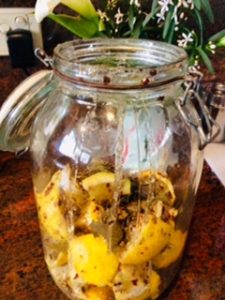 Someone gave Meera Govil a bag of lemons so her 89-year-old mum, Raj, decided to make some lemon pickle with some of them. Here is a video of Raj making the pickle and below is the recipe.
Someone gave Meera Govil a bag of lemons so her 89-year-old mum, Raj, decided to make some lemon pickle with some of them. Here is a video of Raj making the pickle and below is the recipe.
il-I26xwc7g
2 kgs lemons, washed, dried and chopped into quarters
3 teaspoons salt
1 teaspoon sugar
1 teaspoon chilli powder
1 teaspoon ajwain
1 teaspoon fennel seeds (aka saunf)
1 teaspoon cloves
1 teaspoons black peppercorns
4 bay leaves
½ cup mustard oil
¼ teaspoon asafoetida (aka heeng)
In a large bowl or wok, rub the lemons in the salt, sugar, chilli powder, ajwain, fennel seeds (aka saunf), cloves and black peppercorns.
Add the bay leaves.
Warm the mustard oil with the asafoetida (aka heeng) and pour over the lemons.
Place the lemons in a clean, dry jar. Close the lid and put in a sunny spot for 7 days – giving it a good shake every day before bringing it in at night and when taking it out. It will then be ready to eat.
Meg’s social isolation week
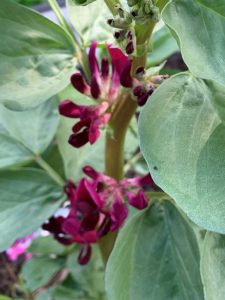 The crimson broad beans are living up to their name and provide a splash of rich colour in the veggie patch (see photo). I expect to be picking by December. The snow peas Yakumo Giant are also reflecting their name, extending well beyond the supports that I had prepared. We have been picking snow peas for the past week and find that frequent picking encourages more flowers and more peas.
The crimson broad beans are living up to their name and provide a splash of rich colour in the veggie patch (see photo). I expect to be picking by December. The snow peas Yakumo Giant are also reflecting their name, extending well beyond the supports that I had prepared. We have been picking snow peas for the past week and find that frequent picking encourages more flowers and more peas.
We are now harvesting armfuls of rainbow chard and oversized spring onions. These have been blanched and frozen or turned into traditional filo tarts with ricotta. However, the cooler weekend has led to baking again, with a tray of muffins using the last of our frozen summer youngberries.
Basic muffins
1¼ cups self-raising flour
½ cup caster sugar
⅔ cup milk
1 egg
⅓ cup vegetable oil
1 teaspoon vanilla
around 200g of frozen berries
Mix the vegetable oil, egg and milk together then add to the dry ingredients. Mix well.
Add the vanilla.
Fold through the frozen berries (gently so that the mix does not discolour).
Add to oiled muffin pan or use patty pans/ muffin liners. Bake at 180degC for around 20 minutes.
This recipe is very flexible. You can substitute any chopped fruit for the berries or use things like chocolate chips. You can use wholemeal self-raising flour instead. You can add things like flaked almonds or a sprinkle of raw sugar to the top before baking.
Reader photos
Last week’s theme – meals you have cooked
6 photos were submitted, each with a story.
 This week’s theme – cakes you have made
This week’s theme – cakes you have made
The photo theme this week is ‘cakes you have made’. As ever, send me your interesting photos, together with a title and (if you want) a story, and I will publish them next week. Please submit any photos by end of play on Sunday at the latest.
To get you started, here is a picture of a gingerbread house that my wife made.
As you can probably tell(!), I’m beginning to run out of ideas for photo themes. Do you have any suggestions for future weeks? Email me.
Which link was clicked most times in the last newsletter?
The most popular link was Leaf, Root & Fruit’s article about composting.
Word of the week – polyembryony
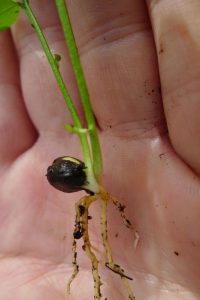 In plants, polyembryony is the phenomenon whereby multiple plants germinate from a single seed. It is apparently common in citrus species, including lemon and mandarin, where one of the seedlings is usually the normal product of fertilisation whilst the other seedlings are genetic clones of the mother. The picture is of a double mandarin embryo.
In plants, polyembryony is the phenomenon whereby multiple plants germinate from a single seed. It is apparently common in citrus species, including lemon and mandarin, where one of the seedlings is usually the normal product of fertilisation whilst the other seedlings are genetic clones of the mother. The picture is of a double mandarin embryo.
Polyembryony in animals means something slightly different but is illustrated by the nine banded armadillo, which always gives birth to four identical young.
Proverb of the month
Too many cooks spoil the broth, sometimes shortened to simply too many cooks. Meaning: if too many people are involved in a task, it will not be done well. This phrase dates back to the 16th Century, the idea being that broth is a simple dish which will taste worse if it has all sorts of ingredients added to it.
There are so many sayings in the English language that there are often sayings with similar meaning and also sayings with opposite meanings. For example, a camel is a horse designed by committee means roughly the same as too many cooks spoil the broth and the more the merrier means roughly the opposite.
Read more food-related proverbs.
Gardening quote of the month
“Flowers are restful to look at. They have neither emotions nor conflicts.” by Sigmund Freud.
Joke of the week
I want to be like a caterpillar. Eat a lot. Sleep for a while. Wake up beautiful.
Upcoming online events
If you know of any events other than those listed below, email me.
Newly announced events
The art of watering: Sunday, 22nd November, 1.30-3pm; $28; organised by Sustainable Gardening Australia. Read more and book on WeTeachMe.
Previously announced events
Wonderful world of worms for kids: Thursday, 1st October, 3-4pm; free; organised by Edendale. Read more and book on WeTeachMe.
Cooking up compost: Saturday, 3rd October, 2-3.30pm; free; organised by Zero Waste Victoria. Read more and book on Humanitix.
Onion and potato bhaji and chutney: Saturday, 3rd October, 4-5.30pm; $29; organised by Cook Indian by the Creek. Read more and book via Facebook.
Queensland fruit fly for home gardeners: Monday, 5th October, 7-8.30pm; free; organised by Edendale. Read more and book on WeTeachMe.
Backyard chooks for beginners: Saturday, 10th October, 10-11.30am; $10; organised by Edendale. Read more and book on WeTeachMe.
Lamb bhuna masala: Saturday, 10th October, 5-6.30pm; $35; organised by Cook Indian by the Creek. Read more and book via Facebook.
Garden bed basics: Sunday, 11th October, 11am-1pm; $donation; organised by Brunswick Tool Library. Read more and book on EventBrite.
Backyard beekeeping basics: Wednesday, 14th October, 7-9pm; $50; organised by CERES. Read more and book on Humanitix.
Chicken biryani: Friday, 16th October, 5-6.30pm; $35; organised by Cook Indian by the Creek. Read more and book via Facebook.
Vegan and gluten free Italian cooking class: Saturday, 17th October, 1-2.30pm; $20; organised by Shop225. Read more and book on EventBrite.
Growing fruit and veg in a wildlife garden: Thursday, 29th October, 7-8.30pm; free; organised by Sustainable Gardening Australia. Read more and book on WeTeachMe.
Sourdough bread making: Saturday, 31st October, 11am-midday; $20; organised by Living & Learning Nillumbik. Read more and book on their website.
Sourdough bread making: Sunday, 1st November, 3-4pm; $20; organised by Living & Learning Nillumbik. Read more and book on their website.
Getting started with veggie gardening: Thursday, 5th November, 7-8.30pm; free; organised by Sustainable Gardening Australia. Read more and book on WeTeachMe.
Home composting Q&A: Monday, 9th November, 7-8.30pm; free; organised by Edendale. Read more and book on WeTeachMe.
Modern bush tucker: Thursday, 12th November, 7-8pm; free; organised by Moreland City Libraries. Read more and book on EventBrite.
Preparing for Summer harvest: Thursday, 12th November, 7-8.30pm; free; organised by Sustainable Gardening Australia. Read more and book on WeTeachMe.
Growing citrus: Saturday, 14th November, 11am-12.30pm; $28; organised by Sustainable Gardening Australia. Read more and book on WeTeachMe.
Open Table offer their weekly no waste cook club workshops free and online on Saturdays. As well as cooking (which is actually optional), you will learn about food waste and composting. Register on EventBrite.
All The Dirt is a weekly podcast about gardening.

